Pros
Cons
Tour & Design
Tour**
The Audio-Technica ATH-W5000s have an interesting mix of various design elements.
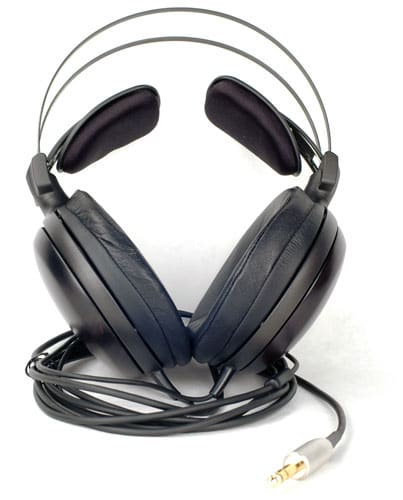
For a sense of scale, the plug above is a large 1/4-inch affair.
The ear cups are capped off with striped ebony wood, which looks incredibly snazzy.
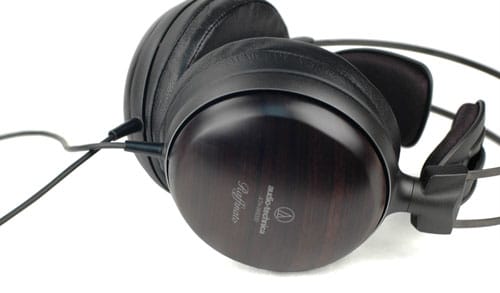
***We're sorry, but if you look at the above image and don't think, 'wow, these look expensive,'
then you quite obviously have a different opinion than our own.***
The ear cups themselves have lambskin-lined padding.
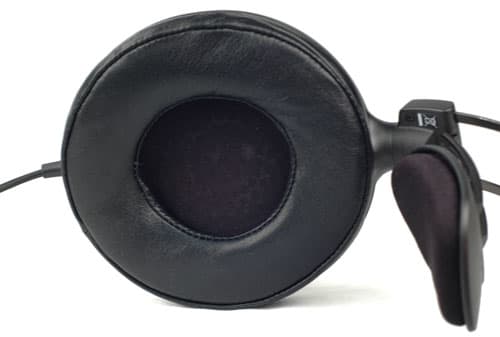
Lambskin pads will either strike you as luxurious or cruel. Either way, they're really soft.
One somewhat uncommon design feature is the band. The band is actually made up of two metallic ribbons that don't actually sit along your head. The paddles are what hold the headphones in place.
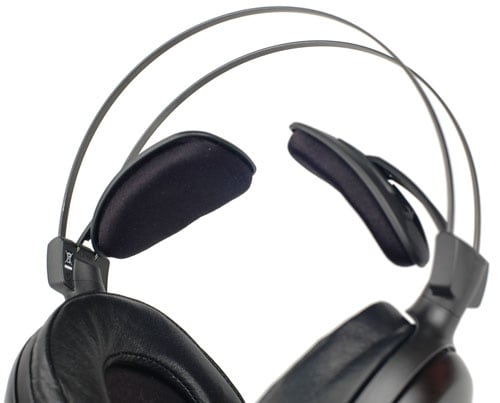
The paddles do have padding, which is comfortable.
As always, we took a few pictures with the headphones on HATS. Use these images to get a small sense of what they might look like on you, or a head-and-torso-simulating robot of your choice.
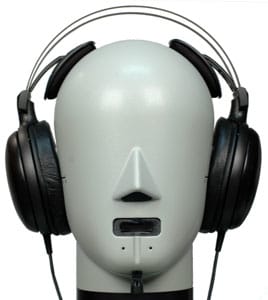
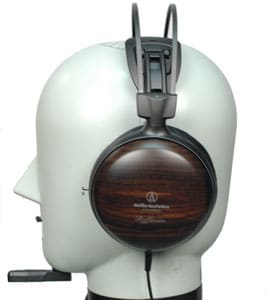
HATS has an average-sized head. If you have a head of a similar size, the W5000s will sit low and loom large.
In The Box
In the ATH-W5000s gigantic, opulent, velour-lined box you'll find the headphones and a soft bag.
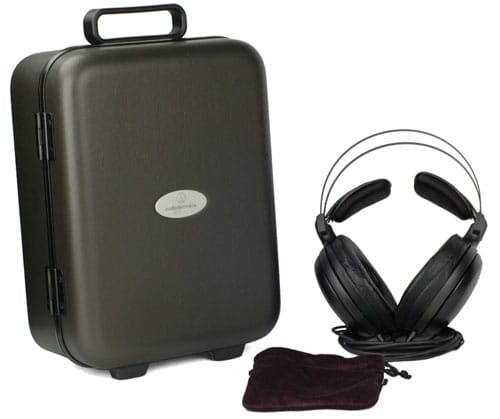
The ATH-W5000s seem pretty sturdy. The ear cups are wood and a good quality plastic. The band is metal and doesn't seem like it'd break easily. The cord is thick and well insulated. The cord guards are excellent. The one area that's questionable is the neck split, which doesn't have cord guards. This area is not likely to incur stress, and even if it were, the cord is rugged enough to absorb the abuse.
The head paddles are moving parts that involve springs, which run the risk of wear and tear. Other than this one area, however, the ATH-W5000s are solid.
The ATH-W5000s seem simultaneously classy and silly. Looking at them by themselves, they're an impressive piece of hardware. They have wood on the outside of their ear cups, and certainly look well put together. Holding this in your hand, you'd be able to tell it was a nice set of headphones.
On your head is a different story. Since the paddles hold these things on your head, the two bands hover above you like overly blatant halos in religious paintings. Also, the headphones are large; larger than typical over-ears. The W5000s will appear to be devouring your head.

***If you don't mind two metal arcs hovering over your head,
then the ATH-W5000s are for you.***
Now, since the first and second paragraphs deal with entirely different facets of aesthetic quality that sort of cancel each other out, we gave them a 5 and leave where they fall up to you. If you're planning on using them in private, rate these things an 8, because people will only be seeing them when they sit on your desk. If you plan on using these in public, consider them a 4. It's not that we don't like their look, it's just that the wooden ear cups say, 'I am classy,' and the head orbits say, 'I am a DJ in my spare time.' If you have a turntable in your study and put together beats while sipping brandy in a red smoking jacket, then the ATH-W5000s are the perfect look for you.
Sound Quality
**
About our testing:**
For more information on our tests, read this article.
**Frequency Response** (*2.69**)*
What we found:
The ATH-W5000s had a bit of an issue with high-frequency sounds, which we thought was a bit odd since our initial impression was they focused too much on mid-to-high-end frequencies. We ran this test multiple times, but that downward spike towards 7kHz was always present. Other than this spike, the ATH-W5000s did a good job. We're guessing that hump in the middle is indicative of our initial impression, and bass insn't bumped up as much as you'd see on typical headphones.
Overall, it's a bit wonky of a frequency response, especially for a set of high-end headphones. We ran this test multiple times, and found the issues towards the high end varied a bit in their severity, but were constant in their appearance.
One theory we came up with is that a lot of this deemphasis comes from sound leaking out of the headphones, due to the poor seal. If that is the case, then the ATH-W5000s would actually have done very well on this test.
How the Audio-Technica ATH-W5000 compares:
What is frequency response?
Your headphones' frequency response refers to the ways in which they emphasize any given frequency. Dynamic headphones tend to alter various levels, such as giving boost to the bass or to various frequencies in the high end.
How the test works:
The way we test frequency response is a dark and mysterious art. First we put the headphones on HATS, our head and torso simulator. We then use SoundCheck, an electroacoustics analysis program, to send a set frequency sweep through the headphones. HATS's precision microphone-ears record the headphones' playback. We then measure the collected playback against the original sound file, specifically looking for the decibel output for each given frequency. For more info, click here.
What we found:
What we found on the ATH-W5000s was very little distortion, except for a bit in that area of mysterious weirdness towards 7kHz. In general, the W5000s did well on this test.
How the Audio-Technica ATH-W5000 compares:
**What is distortion?
**Distortion refers to any differences between the original soundwave and your headphones' output. Distortion is bad, because it fundamentally alters the way your playback sounds. The percentage to look for here is 3%, which is the point at which distortion starts ruining your sound quality.
How the test works:
Our distortion test basically listens for differences between the headphones' playback and the source file they're being fed. We then graph those differences above, as a percentage. If you love learning, you could feasible click here and continue on your knowledge adventure.
What we found:
The ATH-W5000s had some issues with tracking, towards the lower end and towards the high end (the aforementioned inegmatic spot of 'seriously, what's going on here, W5000s?'). That spot towards the high end is where they lost a majority of their points.
If you have a head that's perfectly shaped to accept the W5000s, or if you mod them in some way to get a good fit, they'll probably suffer less from the issues detailed in this section.
How the Audio-Technica ATH-W5000 compares:
**What is tracking?
**Tracking refers to the relative volume levels of the left and right channels. If your playback is telling the left and right channels to output exactly 84dB, it's bad if one plays at 70dB and one plays at 90dB. The ideal output would be both channels playing at 84dB, but even if both are playing at 90dB it's better than an uneven sound.
How the test works:
For this test, we play a frequency sweep through both channels. HATS listens, reports to SoundCheck, and we compare the various decibel levels of each channel to each other, resulting in the graph above. When the blue line dips below the zero mark, it means the right channel was playing louder; rising above the zero mark means the left channel is louder. For more info on tracking or our tracking test, read our main test article.
Isolation
**Maximum Usable Volume** (10.00)
What we found:
The Audio-Technica ATH-W5000s were capable of 121.17dB of playback, which means they passed our test with a golden 10.00. We award a maximum of 10 points to any headphones capable of 120dB or higher with a distortion level of under 3%. Many headphones are capable of 120dB or higher, but will sound like garbage doing so. With the ATH-W5000s, you will be graced with loud music with very minor levels of distortion.
**What is maximum usable volume?
**No one likes bad audio quality, but people often like loud music. When volume is increased, distortion increases as well. Basically, in this section we crank up the volume and keep playing back a sond file, looking for the point at which the playback reaches 3% distortion. As mentioned earlier, 3% distortion is annoyingly noticeable.
How the test works:
This test is essentially a battery of distortion tests at varying volume levels. We keep cranking up the volume until we reach 3% distortion or 120dB. You really don't want to breech either of these thresholds. Anything above 3% distortion will sound like garbage, and anything above 120dB will ruin your hearing. To find out more about this test, click here.
What we found:
The ATH-W5000s weren't the best isolators we've seen. This probably won't be the biggest loss to potential users, however: you really shouldn't be leaving your home or office with these things.
Like most headphones without active cancellation, the ATH-W5000s block out more high-frequency sounds than lower ones.
Again, if you can somehow get the ATH-W5000s to contour to your head perfectly, they'll likely isolate a bit better.
How the Audio-Technica ATH-W5000 compares:
**What is isolation?
**Isolation refers to the headphones' ability to block out external sound. There are two ways a set of headphones can achieve isolation: active cancellation and passive isolation. Passive isolation just means the headphones are physically obstructing your ear canals. Just about every solid object is capable of passive isolation. Active cancellation uses fancy electronics to accomplish a similar effect. Headphones with active noise cancellation have microphones that listen to ambient noise. The headphones then play back a sound with an inverse amplitude. The ambient noise is then literally cancelled out by its inverse. The problem with active cancellation is that it has the tendency to cancel out sounds you do want to hear, or create noise you definitely don't want to hear. The technology is excellent at blocking bass noise, however, while regular in-ears excel at blocking out high-end noise.
How the test works:
Our isolation test is a bit more obvious than our other tests. We outfit HATS with the headphones, then blast it with noise. Fortunately, we know exactly how much noise we're shooting out, so by measuring the amount HATS actually hears we can figure out how much sound is blocked out at each different frequency. For more info on this awesome test – or any of our other, equally awesome tests – click this link.
What we found:
The ATH-W5000s leak, but they do so very directionally. Unless you have a very specific head shape, there will be a gap between your head and the top of the ear cups. Sound will leak out of this opening, but not much sound will leak out elsewhere. All in all, while the ATH-W5000s did a good job blocking leakage, it is present; it just isn't particularly loud.
What is leakage?
Leakage refers to any sound escaping the headphones. Leakage is bad if you're in a library, but not really an issue if you're going to be listening in private. In fact, a lot of leakage is generally indicative of an open soundstage.
How the test works:
To test leakage, we outfit HATS with the headphones, then pipe some pink noise through them. We have a microphone set up a few inches away to pick up on any sound that escapes.
Comfort
Overall, the W5000s are very comfortable. The pads are gigantic and spread the pressure out evenly across the wearer's head. The paddles that keep the headphones from slipping downward don't exert much pressure. While these headphones are gigantic, they don't feel heavy. If you twist your head around quickly, you might be able to throw the headphones out of place, but chances are you aren't going to be doing much headbanging with your $1000 headphones.
Although it might go without saying, these are not portable headphones. Therefore, don't try to take these things to the gym. We assure you, it will not be a comfortable experience.
Not much changes over the course of six hours. The headphones didn't get particularly heavy or tight or anything.
**Customizability** (*1.50**)*
The ATH-W5000s don't have much in the way of customizability. The cups can rotate in a small arc and the head paddles can accommodate various head sizes, but that's about it. The headphones felt big on the 5 heads in our office that wore them: there was always a gap between the top 25% of the cup padding and the wearer's head.
Usability
**Cable Connectivity** (11.59*)*
The Audio-Technica ATH-W5000s have just over 10 feet of cord for you to play around with. This is a solid length for a set of at-home headphones. Unless you live in some Victorian-era estate, the ATH-W5000s will be able to hook up to a system on the other side of the room.
Other than a long cord, however, the ATH-W5000s don't offer much in terms of connectivity. The plug ends in a 1/4-inch jack and doesn't come with an 1/8-inch adapter. This is annoying. Sure, chances are the people dropping $1000 on a set of headphones are going to connect to their $10,000 audio setup, which will only accept 1/4-inch plugs and will, in fact, self-destruct if it senses an iPod in the same room. With the abundance of lossless audio formats and more and more media players offering pristine playback, the ability to hook up to such a device would have been appreciated. If you want such functionality, you'll have to make an additional purchase.
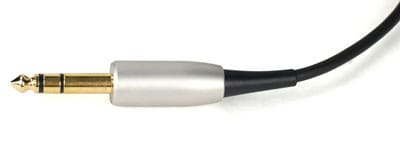
***We've realized (too late) that we've in no way provided a sense of scale in the above image,
and that, to the untrained eye, this 1/4-inch plug would look indistinguishable from an 1/8-inch plug.
We apologize.***
The ATH-W5000s aren't portable. First of all, they are absolutely gigantic. Secondly, fitting 10 feet of cord into a normal-sized pocket isn't the easiest thing to do. Thirdly, the headphones will shift a lot as you move. We would recommend only using these headphones indoors.
The ATH-W5000s do come with a case, which should help you carry them safely from place to place. The interior of the case looks suspiciously like Dracula's coffin.
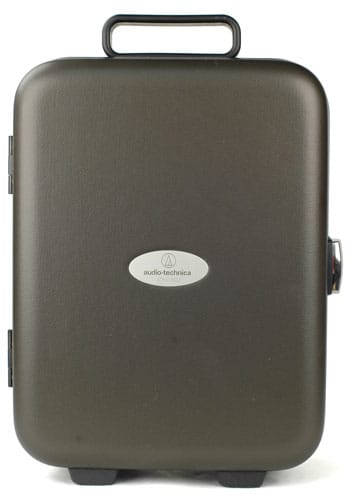
Sure, the case looks inauspicious now, but don't let your guard down.
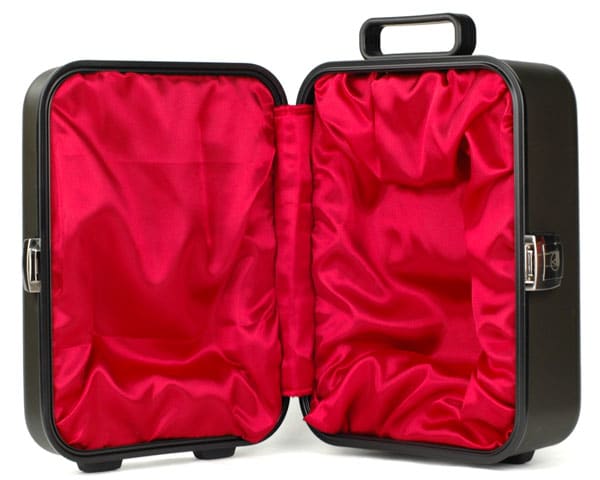
Shazam!
The ATH-W5000s are somewhat annoying to maintain, simply because their cup padding is a pain to put back on. Here's a shot of the cups before you start randomly removing its pieces:

If you do decide to take off the pads (which we really don't recommend given how annoying they are to refit) you will see this:
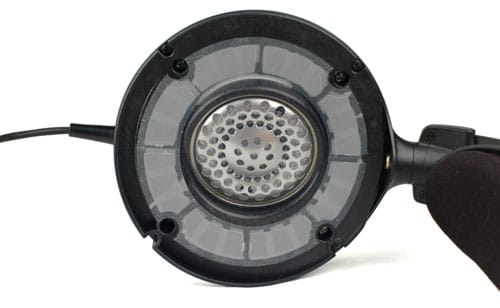
Beautiful. From here, you'll need a thin Phillips-head screwdriver to get out all the screws. The big screws are really the only ones you need to worry about. These will remove the wooden backs, revealing this fuzzy scene:
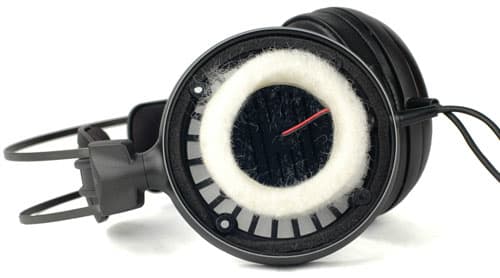
And, while we're here, one more picture with the fuzz removed:
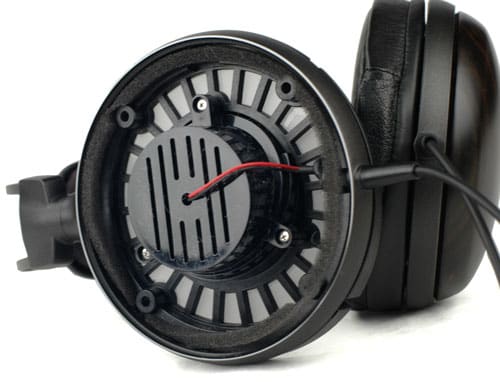
From here you can keep unscrewing. We weren't able to, because they were screwed in really tightly and we didn't want to risk stripping them, since they probably cost $40 themselves.
Battery Dependency
The ATH-W5000s do not require batteries to operate. Just plug them in and listen. For this we awarded them some points.
Audio Technica ATH ESW9 Comparison
Both of these headphones feature similar design elements, but they have vastly different looks. Despite their prices, we actually think the ATH-ESW9s do a better job of capturing the sophisticated look.
In terms of durability, the two sets are about the same.
These two headphones have very similar frequency responses. It isn't that unusual for different headphones by the same company to have similar sounds. The ATH-W5000s actually have a slightly worse response, but not by a significant amount. Given the range of uncertainty that can value from test to test, consider the two headphones equally matched on this battleground.
Here the ATH-ESW9 has a slight advantage because they don't have any weirdness towards the high end. Both have very low overall distortion levels, however, and the average listener wouldn't notice the difference.
The ATH-ESW9s again avoid wonkiness towards their high end, which hurts the ATH-W5000s here. Overall, however, they have very similar tracking.
Again, the differences below are likely due to a fit issue. The ATH-ESW9s form a much better seal with their user's head, which allows them to isolate users a bit better. If you're considering either, however, isolation shouldn't be a determining factor.
The ATH-W5000s win this match-up handily, because they're comfortable and the ATH-ESW9s are super tight. If one were to look only at this match-up, it might be easy to jump to the conclusion that Audio-Technica headphones often have fit issues. This is not the case, however, and these two are the only ones we've reviewed so far from Audio-Technica that have such issues.
With super-high-end headphones like the W-5000, the only thing we can recommend is to try them out for yourselves. When such a large sum of money comes into play, chances are you aren't going to leave your final decision to some internet review, even when that review is as highly scientific and rigorous and handsome as this one.
In terms of cash and quality, the ATH-ESW9s will give you more for each dollar spent. Really, however, if you're going for a bargain, neither are the best bet. Objectively, in the realm of this match-up, however, the ATH-ESW9s win.
Beyerdynamic DT 990 PRO Comparison
Within this comparison is an interesting aesthetic conundrum. From the sides, the ATH-W5000s look significantly classier, thanks in part to their wooden ear cups. From the front, however, they make your head look like Saturn (we think this is silly; should you be reading this in the future, where halos have come into fashion, feel free to assert your own assessments over our own).
The DT 990 PROs had a significantly more even frequency response than the ATH-W5000s, although they too had some issues towards the high-end. Both have a relatively even response, but the DT 990 PROs manage to snag this category.
There really isn't much to say regarding distortion other than, 'Hey, guys, where'd you put that distortion? I can't seem to find it anywhere!' We really wouldn't recommend saying this, actually, because we tried saying this in the office once and no one really thought it was funny, not even the guy who is into headphones.
Look at these two tracking graphs. Knowing that tracking displays the relative volume levels of each channel, we feel it's easy to discern which had the most even playback. This being said, the ATH-W5000s weren't horrible-terrible, they just had that issue towards the high end.
Neither are good.
The DT 990 PROs are some of the most comfortable headphones we've tried on. The only issue we found with them is that, during very long listening sessions of over 6 hours, you might want to re-adjust the band slightly to avoid feeling pressure. They feel secure without feeling tight, and are just magically comfortable in general. The ATH-W5000s have a slight fit issue, which you can see in the pictures below: they don't really contour to the head well.
Both sets of headphones are comfortable. Sometimes the DT 990 PROs can cause some top-of-the-head pressure, sometimes the ATH-W5000s feel big. We recommend trying both on.
In this match-up, we really do like the DT 990 PROs more. Sure, they don't look nearly as expensive as the ATH-W5000s, but we're not you, so we feel haven't the foggiest how much such a thing will mean to you, personally.
In terms of audio quality, we side with the numbers, which side with the DT 990 PROs. The numbers continue to side with the DT 990 PROs across the board, including our value score. The DT 990 PROs are great and well-priced for what they offer. If you're looking for fancy, however, the ATH-W5000s win.
Grado Labs SR60 Comparison
The Grado SR60s have a definite nostalgia to their design, and since the 80s are currently back in style, feel free to enjoy their aesthetic once again, either legitimately or ironically. The SR60s do not look high end at all, however.
The ATH-W5000s also feature a much sturdier design. They are made of wood from the (former) mightiest tree in all the land, while the SR60s seem to be made from the same plastic as pastel Easter eggs.
Both headphones have some issues with frequency response. Although the SR60s manage to stay within our limits for the most part, they have a dip towards the high end as well. Although neither are great, the SR60s gain the advantage here.
If you've read any other part of this review, you're well aware that the ATH-W5000s lose a bit of audio quality due to their poor fit (in our estimates at least). The SR60s laugh at this failing and do the same thing, but magnified significantly. Part of the reason that many headphones have abandoned the foam ear pads is because they create a horrible seal with the user's head. In fact, we'd go so far as to say it's the least commercially feasible padding that's currenty available, at least to our knowledge. Granted, the sheer number of qualifiers in the previous sentence do a bit to undermine its impact, but our point stands regardless.
Again, while neither headphone had stellar performance here, the SR60s have a slight edge by not being quite as bad.
Again, neither set of cans is good at isolating. The SR60s block out about as much sound as a damp sponge that's only gently grazing the outside of your ear.
The ATH-W5000s win here. Even though they feel big, they aren't scratchy like the SR60s pads.
The ATH-W5000s are the better set of headphones by far. While the SR60s are generally looked upon favorably by audiophiles, they simply can't compete in any area except for price. With a $900 discrepency between the two, it's hard to rag on them for being inferior.
Sennheiser HD 555 Comparison
The Sennheiser HD 555s look very plasticky and aren't put together particularly well. The ATH-W5000s look better, and feature better construction. Even with the whole double-arc weirdness that'll be hovering above your head they manage to look snazzier.
Both headphones have a bit of an issue with frequency response. One thing to notice: our HD 555 graph is from our older days when we started measuring at 20Hz. Please keep this in mind for accuracy's sake.
The HD 555 nets a small advantage here.
The same 'oh shucks, our HD 555 graph is old and shows junk data' speech goes for distortion as well: ignore everythign before 100Hz, because it's not reliable data and we don't score on it.
Both headphones have similarly low distortion, only the ATH-W5000s have a bit of a blip towards the high end and the HD 555s have some rumblings of distortion towards their low end.
Both headphones did about the same on tracking, with the HD 555s being slightly less erratic.
Keep scrolling.
The ATH-W5000s feel a bit big, but the HD 555s felt a bit scratchy. Overall, we thought they were about the same comfort level.
We've mentioned the price to death at this point, but it's really the most significant feature about the ATH-W5000s (aside from their swank facade). The HD 555s aren't perfect, but they offer solid audio quality at an affordable price. If you want, you can even cut down a tree and make your own wooden backs for them.
Conclusion
Meet the tester
Mark Brezinski works on the Home Team, reviewing refrigerators, minifridges, dishwashers, washing machines, dryers, air conditioners, air purifiers, and fans.
Checking our work.
Our team is here to help you buy the best stuff and love what you own. Our writers, editors, and experts obsess over the products we cover to make sure you're confident and satisfied. Have a different opinion about something we recommend? Email us and we'll compare notes.
Shoot us an email